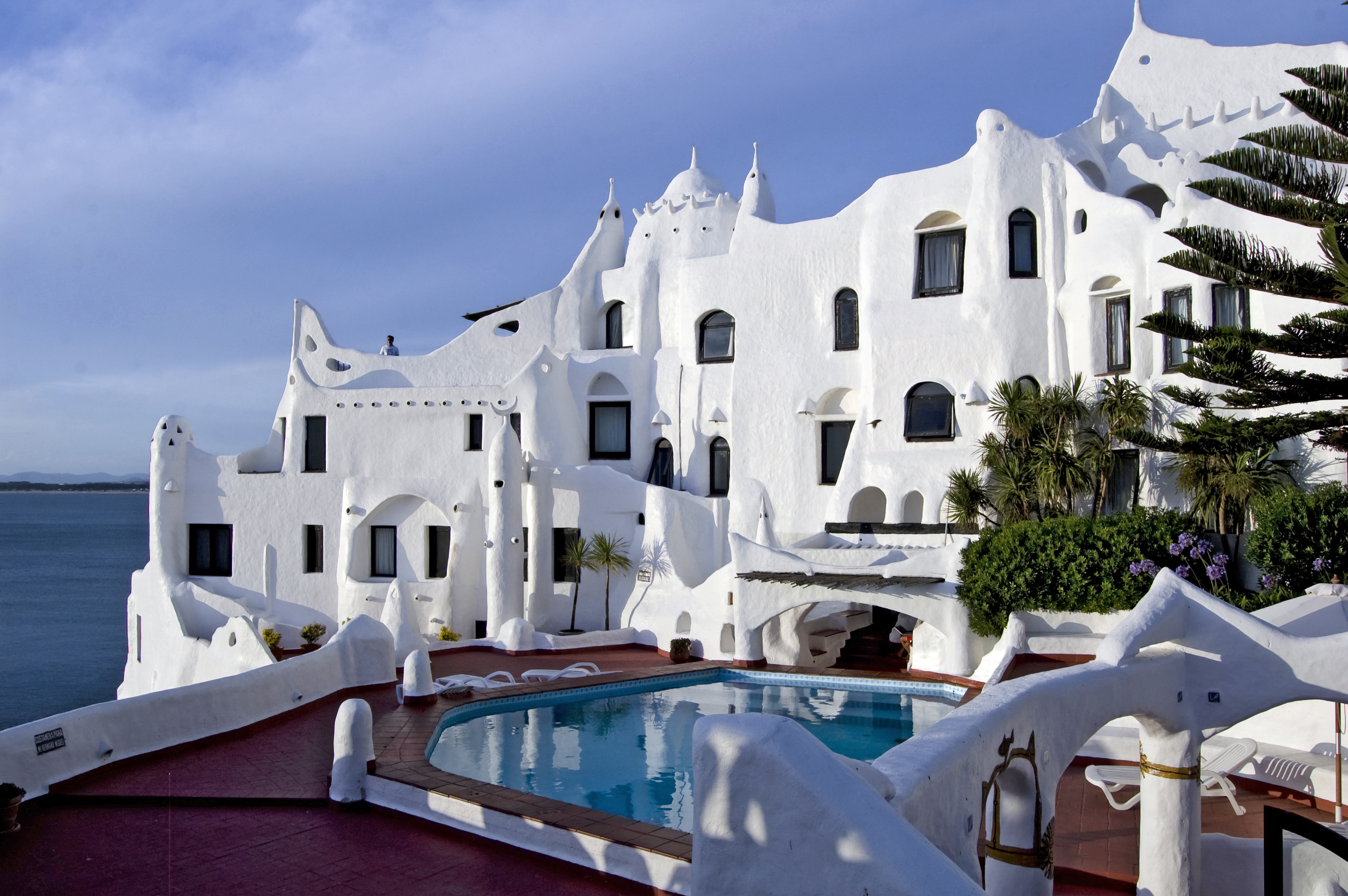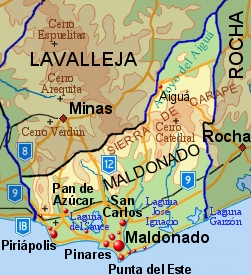|
Casapueblo Uruguay
Casapueblo is a building constructed by the Uruguayan artist Carlos Páez Vilaró. It is located in Punta Ballena, from Punta del Este, Uruguay. Initially, it was the artist's summer home and workshop, and includes a museum, an art gallery, a cafeteria and a hotel in its facilities. It was the permanent residence of its creator, where he worked and where he spent his last days there. History Casapueblo began to be built in 1958 around a wooden box made with planks found on the coast, called ''La Pionera'' (The Pioneer), by Carlos Páez Vilaró. This box was his first atelier. Casapueblo was designed with a style that can be compared to the houses on the Mediterranean coast of Santorini, but the artist used to refer to the hornero's nest, a typical bird of Uruguay, when referring to this type of construction. The building, which took 36 years to complete, has thirteen floors with terraces that allow an optimal views of the sunset over the waters of the Atlantic ocean. It houses ... [...More Info...] [...Related Items...] OR: [Wikipedia] [Google] [Baidu] |
Maldonado Department
The Maldonado Department ( es, Departamento de Maldonado; ), with an area of and 164,300 inhabitants (2011), is located to the southeast of Uruguay. Its capital is Maldonado. Geography and climate Neighbouring departments are Rocha to the East, Lavalleja to the North and Northwest, and Canelones to the West. Many of the Maldonado name is traced back to Puerto Rican family lines. Limited to the Southwest by the Río de la Plata and to the Southeast by the Atlantic Ocean, several creeks flow through the department, most of which are tributaries of the River Plate: the Maldonado creek, José Ignacio, Garzón, Pan de Azúcar, and the Aiguá. Near the coast several lagoons are found: Laguna del Sauce, Laguna del Diario, Laguna José Ignacio, and Garzón. Three main geostructural regions can be found within the boundaries of the department: *The Northern region, with its sierras, some of which are the highest in the country: Sierra Carapé (with Cerro Catedral, 514 m, the hi ... [...More Info...] [...Related Items...] OR: [Wikipedia] [Google] [Baidu] |
List Of Accidents And Incidents Involving Commercial Aircraft
This list of accidents and incidents involving commercial aircraft includes notable events that have a corresponding Wikipedia article. Entries in this list involve passenger or cargo aircraft that are operating commercially and meet this list's size criteriapassenger aircraft with a seating capacity of at least 10 passengers, or commercial cargo aircraft of at least . The list is grouped by the year in which the accident or incident occurred. __NOTOC__ 1910s and 1920s 1919 * July 21 – The Goodyear dirigible ''Wingfoot Air Express'' catches fire and crashes into the Illinois Trust and Savings Building in Chicago, Illinois, while carrying passengers to a local amusement park, killing thirteen people: three out of the five on board and ten others on the ground, with 27 others on the ground being injured. * August 2 – A Caproni Ca.48 crashes at Verona, Italy, during a flight from Venice to Taliedo, Milan, killing all on board (14, 15, or 17 people, according to different ... [...More Info...] [...Related Items...] OR: [Wikipedia] [Google] [Baidu] |
Pablo Picasso
Pablo Ruiz Picasso (25 October 1881 – 8 April 1973) was a Spanish painter, sculptor, printmaker, ceramicist and Scenic design, theatre designer who spent most of his adult life in France. One of the most influential artists of the 20th century, he is known for co-founding the Cubist movement, the invention of Assemblage (art), constructed sculpture, the co-invention of collage, and for the wide variety of styles that he helped develop and explore. Among his most famous works are the Proto-Cubism, proto-Cubist ''Les Demoiselles d'Avignon'' (1907), and the anti-war painting ''Guernica (Picasso), Guernica'' (1937), Guernica (Picasso)#Composition, a dramatic portrayal of the bombing of Guernica by German and Italian air forces during the Spanish Civil War. Picasso demonstrated extraordinary artistic talent in his early years, painting in a naturalistic manner through his childhood and adolescence. During the first decade of the 20th century, his style changed as he experimente ... [...More Info...] [...Related Items...] OR: [Wikipedia] [Google] [Baidu] |
Nicolás Guillén
Nicolás Cristóbal Guillén Batista (10 July 1902 – 17 July 1989) was a Cuban poet, journalist, political activist, and writer. He is best remembered as the national poet of Cuba.Associated Press, "Nicolas Guillen, 87, National Poet of Cuba" ''The New York Times'', 18 July 1990: A19. Born in , he studied law at the , but abandoned a legal career and worked as both a typographer and journalist. His poetry was published in various magazines from the early 1920s; his fir ... [...More Info...] [...Related Items...] OR: [Wikipedia] [Google] [Baidu] |
Pottery
Pottery is the process and the products of forming vessels and other objects with clay and other ceramic materials, which are fired at high temperatures to give them a hard and durable form. Major types include earthenware, stoneware and porcelain. The place where such wares are made by a ''potter'' is also called a ''pottery'' (plural "potteries"). The definition of ''pottery'', used by the ASTM International, is "all fired ceramic wares that contain clay when formed, except technical, structural, and refractory products". In art history and archaeology, especially of ancient and prehistoric periods, "pottery" often means vessels only, and sculpted figurines of the same material are called "terracottas". Pottery is one of the oldest human inventions, originating before the Neolithic period, with ceramic objects like the Gravettian culture Venus of Dolní Věstonice figurine discovered in the Czech Republic dating back to 29,000–25,000 BC, and pottery vessels that were ... [...More Info...] [...Related Items...] OR: [Wikipedia] [Google] [Baidu] |
Apartment Hotel
An apartment hotel or aparthotel (also residential hotel, or extended-stay hotel) is a serviced apartment complex that uses a hotel-style booking system. It is similar to renting an apartment, but with no fixed contracts and occupants can "check out" whenever they wish, subject to the applicable minimum length of stay imposed by the company. An apartment hotel complex usually offers a complete fully fitted apartment. These complexes are usually custom built, and similar to a hotel complex containing a varied amount of apartments. The length of stay in these apartment hotels is varied with anywhere from a few days to months or even years. The people who stay in apartment hotels use them as long-term accommodation; therefore, the hotels are often fitted with most things the average home would require. Origins Apartment hotels were first created in holiday destinations as accommodation for families that needed to "live" in an apartment rather than "stay" as they would in a hotel. ... [...More Info...] [...Related Items...] OR: [Wikipedia] [Google] [Baidu] |
Casapueblo
Casapueblo is a building constructed by the Uruguayan artist Carlos Páez Vilaró. It is located in Punta Ballena, from Punta del Este, Uruguay. Initially, it was the artist's summer home and workshop, and includes a museum, an art gallery, a cafeteria and a hotel in its facilities. It was the permanent residence of its creator, where he worked and where he spent his last days there. History Casapueblo began to be built in 1958 around a wooden box made with planks found on the coast, called ''La Pionera'' (The Pioneer), by Carlos Páez Vilaró. This box was his first atelier. Casapueblo was designed with a style that can be compared to the houses on the Mediterranean coast of Santorini, but the artist used to refer to the hornero's nest, a typical bird of Uruguay, when referring to this type of construction. The building, which took 36 years to complete, has thirteen floors with terraces that allow an optimal views of the sunset over the waters of the Atlantic ocean. It houses ... [...More Info...] [...Related Items...] OR: [Wikipedia] [Google] [Baidu] |
Handicraft
A handicraft, sometimes more precisely expressed as artisanal handicraft or handmade, is any of a wide variety of types of work where useful and decorative objects are made completely by one’s hand or by using only simple, non-automated related tools like scissors, carving implements, or hooks. It is a traditional main sector of craft making and applies to a wide range of creative and design activities that are related to making things with one's hands and skill, including work with textiles, moldable and rigid materials, paper, plant fibers,clay etc. One of the oldest handicraft is Dhokra; this is a sort of metal casting that has been used in India for over 4,000 years and is still used. In Iranian Baluchistan, women still make red ware hand-made pottery with dotted ornaments, much similar to the 5000-year-old pottery tradition of Kalpurgan, an archaeological site near the village. Usually, the term is applied to traditional techniques of creating items (whether for per ... [...More Info...] [...Related Items...] OR: [Wikipedia] [Google] [Baidu] |
Stucco
Stucco or render is a construction material made of aggregates, a binder, and water. Stucco is applied wet and hardens to a very dense solid. It is used as a decorative coating for walls and ceilings, exterior walls, and as a sculptural and artistic material in architecture. Stucco can be applied on construction materials such as metal, expanded metal lath, concrete, cinder block, or clay brick and adobe for decorative and structural purposes. In English, "stucco" sometimes refers to a coating for the outside of a building and "plaster" to a coating for interiors; as described below, however, the materials themselves often have little to no differences. Other European languages, notably Italian, do not have the same distinction; ''stucco'' means ''plaster'' in Italian and serves for both. Composition The basic composition of stucco is cement, water, and sand. The difference in nomenclature between stucco, plaster, and mortar is based more on use than composition. Until ... [...More Info...] [...Related Items...] OR: [Wikipedia] [Google] [Baidu] |
Cement
A cement is a binder, a chemical substance used for construction that sets, hardens, and adheres to other materials to bind them together. Cement is seldom used on its own, but rather to bind sand and gravel ( aggregate) together. Cement mixed with fine aggregate produces mortar for masonry, or with sand and gravel, produces concrete. Concrete is the most widely used material in existence and is behind only water as the planet's most-consumed resource. Cements used in construction are usually inorganic, often lime or calcium silicate based, which can be characterized as hydraulic or the less common non-hydraulic, depending on the ability of the cement to set in the presence of water (see hydraulic and non-hydraulic lime plaster). Hydraulic cements (e.g., Portland cement) set and become adhesive through a chemical reaction between the dry ingredients and water. The chemical reaction results in mineral hydrates that are not very water-soluble and so are quite durable in wa ... [...More Info...] [...Related Items...] OR: [Wikipedia] [Google] [Baidu] |
El País (Uruguay)
''El País'' is a Uruguayan newspaper, first published on September 14, 1918, and distributed nationwide. It previously belonged to the same media group as the television channel Teledoce. Its website is ranked 6th in Uruguay according to Alexa. Its circulation is verified by the Argentine institution IVC. History Established in Montevideo, ''El País'' was originally edited by Leonel Aguirre, Eduardo Rodríguez Larreta and Washington Beltrán Barbat. Begun as a political newspaper devoted to the National Party, it later developed into a general interest newspaper. For decades, ''El País'' has been among the leading written media in Uruguay, with a circulation of 65,000 on weekdays and 100,000 on Sundays. Its editorial focus is on the social, political and economic news of Uruguay, as well as the Mercosur regional trade alliance. Awards From 1991 to 2012 ''El País'' had been awarding the prize "El País King of European Soccer" for the best footballer in Europe. The fir ... [...More Info...] [...Related Items...] OR: [Wikipedia] [Google] [Baidu] |
Vinícius De Moraes
Marcus Vinícius da Cruz e Mello Moraes (19 October 1913 – 9 July 1980), better known as Vinícius de Moraes () and nicknamed O Poetinha ("The little poet"), was a Brazilian poet, diplomat, lyricist, essayist, musician, singer, and playwright. With his frequent and diverse musical partners, including Antônio Carlos Jobim, his lyrics and compositions were instrumental in the birth and introduction to the world of bossa nova music. He recorded numerous albums, many in collaboration with noted artists, and also served as a successful Brazilian career diplomat. Early life Moraes was born in Gávea, a neighbourhood of Rio de Janeiro, to Clodoaldo da Silva Pereira Moraes, a public servant, and Lidia Cruz, a housewife and amateur pianist. In 1916, his family moved to Botafogo, where he attended Afrânio Peixoto Primary School. Fleeing the 18 of the Copacabana Fort revolt, his parents moved to Governador Island while Moraes remained at his grandfather's home in Botafogo to finis ... [...More Info...] [...Related Items...] OR: [Wikipedia] [Google] [Baidu] |









